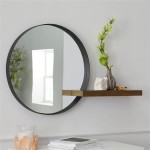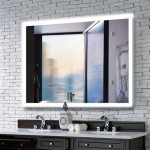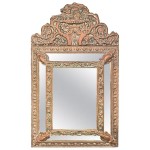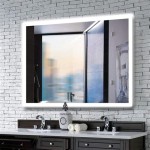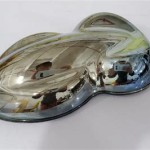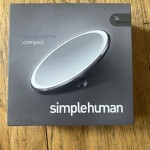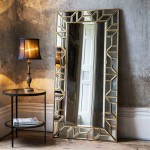How to Safely and Effectively Remove a Mirrored Wall
Removing a mirrored wall can dramatically change a room's appearance, creating a sense of spaciousness and altering light dynamics. However, the process requires careful planning and execution to prevent injury and damage. This guide outlines the necessary steps to safely and effectively remove a mirrored wall.
Assessing the Mirrored Wall
Before beginning the removal process, a thorough assessment of the mirrored wall is crucial. This assessment helps determine the type of installation and potential challenges.
- Mirror Size and Weight: Larger and thicker mirrors are significantly heavier and may require additional assistance for safe removal.
- Installation Method: Mirrors can be adhered directly to the wall with adhesive or mounted using clips and screws. Identifying the method will inform the removal technique.
- Wall Condition: Evaluate the underlying wall for any existing damage or weaknesses. Removing the mirror might exacerbate these issues.
- Accessibility: Ensure the area around the mirrored wall is clear of obstacles for safe maneuvering during removal.
Gathering Necessary Tools and Safety Equipment
Having the right tools and safety equipment is essential for a smooth and injury-free removal process.
- Safety Gear: Heavy-duty gloves, safety glasses, long sleeves, and work boots are crucial for protecting against sharp edges and broken glass. A dust mask is also recommended.
- Tools: Depending on the installation method, tools such as a pry bar, putty knife, hammer, screwdriver, heat gun or hair dryer, and suction cups may be required.
- Drop Cloths and Covering: Protecting the surrounding area with drop cloths minimizes cleanup and prevents damage to flooring.
- Mirror Adhesive Remover: For adhesive-mounted mirrors, a specialized adhesive remover might be necessary to soften the adhesive.
Protecting the Surrounding Area
Taking preventative measures to protect the surrounding area minimizes potential damage and simplifies cleanup.
- Covering Floors and Furniture: Use drop cloths or thick blankets to cover flooring and any furniture near the mirrored wall.
- Taping Off Adjacent Walls: Use painter's tape to protect adjacent walls from scratches or damage during the removal process.
- Removing Nearby Decorations: Remove any paintings, wall hangings, or other decorative items that could be damaged during the removal process.
Removing Adhesive-Mounted Mirrors
Mirrors affixed with adhesive require a different approach than those mounted with clips or screws.
- Applying Heat: Use a heat gun or hair dryer to warm the adhesive, making it easier to separate the mirror from the wall.
- Using a Putty Knife or Pry Bar: Carefully insert a putty knife or pry bar behind the mirror and gently pry it away from the wall. Work slowly and methodically to avoid cracking the mirror.
- Applying Adhesive Remover: If the adhesive is particularly stubborn, apply a specialized mirror adhesive remover according to the manufacturer's instructions.
- Using Suction Cups: Suction cups can provide additional leverage and control while removing larger sections of mirror.
Removing Clip or Screw-Mounted Mirrors
Mirrors installed with clips or screws are generally easier to remove than adhesive-mounted mirrors.
- Locating the Clips or Screws: Identify the location of all clips or screws holding the mirror to the wall.
- Removing the Fasteners: Use a screwdriver to carefully remove the screws or release the clips holding the mirror in place.
- Gently Lifting the Mirror: Once all fasteners are removed, carefully lift the mirror away from the wall. Enlist assistance if the mirror is large or heavy.
Disposing of the Mirror
Proper disposal of the removed mirror is essential to prevent injury and comply with local regulations.
- Wrapping the Mirror: Carefully wrap the mirror sections in thick blankets, cardboard, or other protective material. Clearly label the package as "broken glass" to alert waste handlers.
- Checking Local Regulations: Contact local waste management services for specific guidelines on disposing of large mirrors or broken glass.
- Considering Recycling Options: Some communities offer recycling programs for mirrors and other glass materials. Explore available options in your area.
Repairing the Wall
After removing the mirror, the underlying wall may require repairs before further decoration or use.
- Removing Adhesive Residue: If adhesive was used, carefully remove any remaining residue using a scraper or appropriate solvent.
- Patching Holes and Damages: Use spackling compound to fill any holes or imperfections in the wall. Sand the patched areas smooth once dry.
- Preparing for Redecoration: Prime and paint the repaired wall to prepare it for new décor, wallpaper, or another mirror.
Diy Project Removing Floor To Ceiling Mirrors From A Wall In Our House S Dining Room Jeff Geerling
Mirrored Wall Removal Monks Home Improvements
How To Remove A Bathroom Mirror Lowe S
How To Safely And Easily Remove A Large Bathroom Builder Mirror From The Wall Site Title
How To Remove A Wall Mirror Diy Weekend Project Rustic Mirrors Black
How To Safely Remove A Wall Mirror Diy Network
How To Safely And Easily Remove A Large Bathroom Builder Mirror From The Wall Site Title
How To Remove A Bathroom Mirror Lowe S
How To Remove A Glued Bathroom Mirror From The Wall
2 Step Guide How To Remove A Bathroom Mirror With Clips

